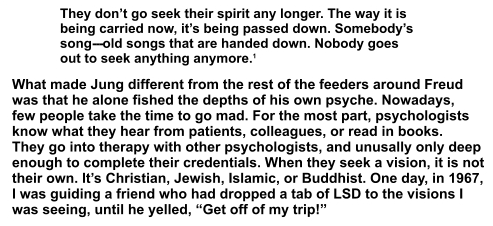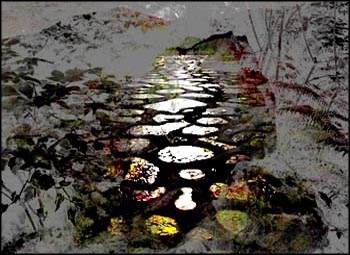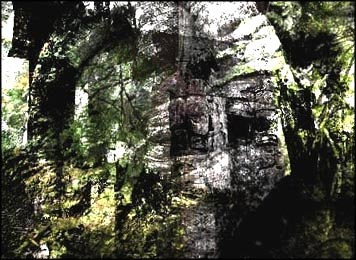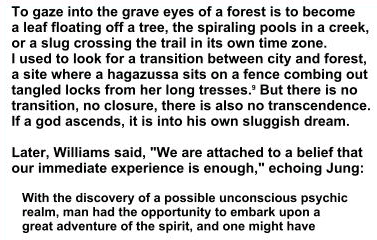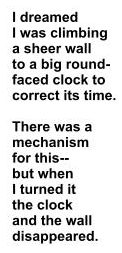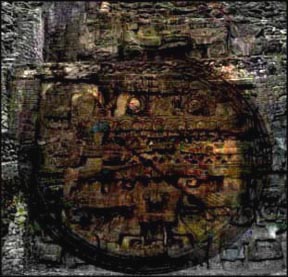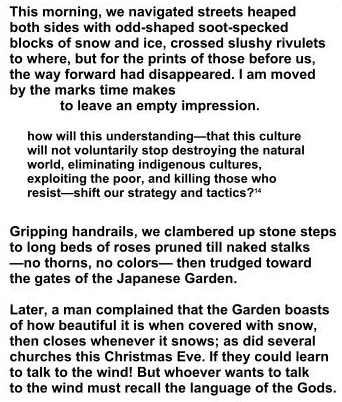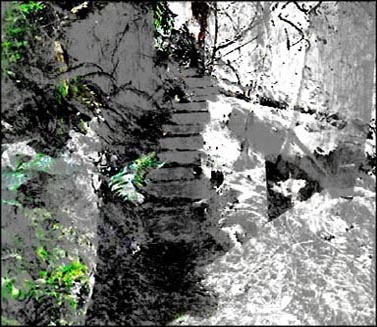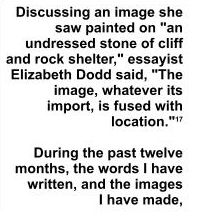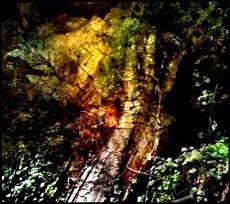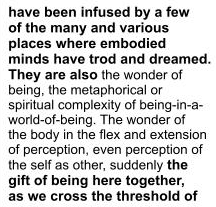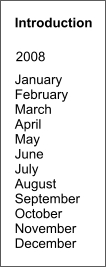
|
|
December 2. Jungians extend what Carl Jung wrote it into the contemporary world. It is not a religion, as faith stops the conversation. It is not a science in which the observer is presumed to be detached from what is observed; although, thanks to the weirdness of quantum psychics, even this ancient church had a deeper mystery: the ruins of the first-century courtyard of Roman buildings, including this pagan temple. Such overbuilding was not uncommon; one religion burying the scientific method is easing into a more psychological paradigm. Jung proposed this when he wrote, "every science is a function of the psyche."2 Was the first image of the Goddess a singular vision, or did it erupt from the symmetry of commensal dreams? Two
of Jung's initiatory dreams were archeological. There are enough
similarities between depth psychology and prehistoric archeology
that further elaboration could be conductive. Analyzing critiques of their book, The Shamans of Prehistory,3 Jean Clottes and J. David Lewis-Williams discuss whether their thesis—that many of the Paleolithic cave paintings are records of psychotropic visions of shamans—should be held to the same standards of proof as the “hard” sciences. Instead of trying to refute the claim that their theory can never be experimentally confirmed, they give examples as to why this is an impossible test for prehistoric archeology to meet. For instance: An archaeologist discovers a piece of charcoal at what was once a hearth. It is radiocarbon dated to the Magdalenian era. One immediate problem is that, although it can be assumed “that the artifact discovered around the fire belonged to those who made the fire,” it can't be proven that it had not been “picked up on an earlier habitation site for some unknown reason and brought there.” They conclude that “the concept of ‘proof’ which we find so often these days in papers and books, as though archaeology needs a scientific boost in order for it to join the exclusive club of the ‘real’ sciences, is properly speaking misleading.”4 Like
Freud, Jung wanted to be accepted as a scientist.
However, in his mature years he gave up yearning for
acceptance in order to study
whatever he desired, including what James Hillman calls “the
poetic basis of mind.”5
In a garden, Danaë holds out an empty cup and suddenly it's raining, if lightly. A homeless man slowly pushes his cart across an intersection, cutting through a string of cars. Horns blow, a driver yells, strollers smile, while he is oblivious to everything except the colors of the leaves. When Cézanne wrote, ”I am still learning from nature, and it seems to me I am making slow progress,” his paintings were already admired by his peers. Maurice Merleau-Ponty added that Cézanne “worked alone, without students, without admiration from his family, without encouragement from the critics.”6 . 7. Kyle Lee Williams, President of Seattle's C.G. Jung Society, delivered a lecture last night on the essay in which Jung laid out some of his most important analogies between psychology, science, and religion.2 Peppered with welcomed questions from the audience, Williams read and elaborated in the chilly sanctuary of a downtown Unitarian Church. She began by saying: "There's something alchemical about reading Jung's work in public." Alchemy's "beauty lies in its materialized language, which at the same time we can never take literally. For us it is in the historical past, in ille tempore, and thus an extensive metaphor, a myth."7O Williams put it this way: We must find "the appropriate ancientness when approaching the nature of the psyche."
Williams addressed "how an idea manifests in history," the idea of a soul. She pointed out how the Roman Catholic Church "was in charge of the definition of the soul," so much so that "even philosophers had to get permission from the Church" to define its nature in their speculations. Then Williams said, "Nobody ever asked the soul itself what it is." Now we are in the post-Enlightenment Era. The Church has eased its stranglehold on the numinous while, breathing again, soul has morphed back into psyche. But psychology, as Jung wrote in the mid-20th Century, "is still a long way from a development similar to that which the other natural sciences have undergone."2
This happened because the same neuron that activated during the original viewing of a specific snippet also fired during recall, and the action began a second or so before the patient reported seeing the clip. That means that ‘the very neuron that was selectively active during the encoding, during the original viewing, suddenly came to life. It essentially replayed, as Williams put it: "We love to think we know it all." We fear that if there is a part of the psyche "not immediately available to consciousness," as with an iceberg whose greater bulk is hidden underwater, in Williams' analogy, "then all our knowledge must be incomplete, and moreover to a degree that we cannot determine."2 That we can never know but fragments of our self, and never have a complete catalog of the universe; that, rather, we must rely on abstract equations, clever technologies, and the insights of mystics and philosophers—is a source of anxiety only the most thoughtful of our species live to regret.
10. Last month, I wrote: "For me, visiting a zoo is like visiting relatives serving a life sentence for the crime of not being human." In the discussion that follows Jean Clottes and J. David Lewis-Williams' essay, "After the Shamans of Prehistory," the archaeologist Linea Sundstrom says, "I recently heard about a study of dreams—regular sleep dreams—and they said that very young children dream about animals, but as they get older their dreams become more diverse and they begin to dream about other things." To which Jean Clottes replied: "It may be that we're hard-wired that way, because for millions of years people have been living in a world where there were far more animals than humans. Our situation is now reversed, but just for the last few generations...
. 13. Strong winds from the east today, snow "crashing into the valley, the coldest air mass in ten years," is expected tomorrow. Weather dances to a divine choreographer: the god is Dionysos, "the one who shatters house walls and institutional walls, who excites women and makes them want to run out into the world,"11 the god who danced in his mother's womb.
20.
It's been snowing for days, each storm denser than the one before. This morning we began walking toward the forest, but turned back, fingers painful even through the weave of woolen gloves. Feet sank to ankles, steadied on slats of cleared gray pavement, then crossed streets of crystal windrows. Tonight we'll dream of walking between white sentinels of silent trees.
For
several days, we've been trying to leave for a house south of here,
but how to get past the ice? The news is grim. Yet each day we
manage to travel further and further toward each other. It is Christmas,
and her eyes are as mysterious as ever.
The old poets knew mythology. Hills and meadows evented again, in their words, cities became strongholds of song and dance. Even in midst of winter storms, souls blossomed. Nothing is conscious that doesn't in some way dream.
24. We take snapshots of places and recall them. But it is only those experiences that congeal into "knots of condensed implications"13 that are the real journey, the soul's journey. The trip may be to another city, another country, a wilderness area, or to the corner grocery store. It is not a matter of distance, or in Paleolithic painted caves there is a double logic, that of the vast chambers and that of the isolated recesses. The latter, where only one or two persons could be at a time, were not often frequented, as we can tell from the scarcity of traces. In their case, the end result, i.e. the image itself, could not have been the main purpose. What must have counted most was the creation of the exoticness of the place. What matters is the consciousness that is the depth of the journey itself.
26.
28. With snow melting into rain we enter the forest, stepping into the creek's boisterous chorus, rising around us: no god emerges silently from its womb. "Often it is not so much a matter of transformation from one state to another: different accounts, songs, dances, paintings seem to assure different states of existence."15 We slip and slide, hand-in-hand, not apart.
When I was a young writer, a well-known poet told me how at age nineteen he had planned the trajectory of his life. Looking back, it seems as if his successful career was indeed "placed solid, by hands / In choice of place, set / Before the body of the mind/ in space and time."16 But now I see that an artist will not want to see in advance where to take the next step. With this in mind, my ankle turns on a slab of ice, balancing again where an anonymous plot of ground meets itself again. 31.
nobody drew the
conclusion: C.G. Jung,"On the Nature of the Psyche." The
Collected Works of C.G. Jung. Vol. 8. Princeton, NJ, 1981. |

